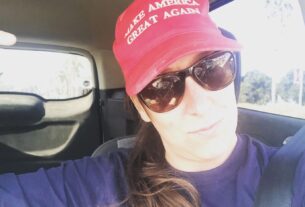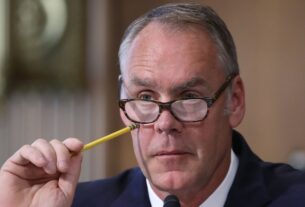
“Life is what is important right now. I wouldn’t take that risk. I just wouldn’t,” one Bureau of Indian Education educator told the agency in mid-July.
The U.S. Department of the Interior – Indian Affairs, which oversees the Bureau of Indian Education, announced last week that it would reopen “brick and mortar schools” under its jurisdiction to the “maximum extent possible” on Sept. 16.
That will affect 53 Bureau of Indian Education schools run by the federal government across 10 states. With President Donald Trump pushing for schools to reopen for in-person learning despite the coronavirus pandemic, his administration has a direct say in the fate of some schools on Native American reservations.
An internal memo sent to bureau-operated schools Friday and shared with NBC News included details of the return to in-person teaching. Families can opt for virtual learning, according to the memo, but instructors must still teach in person, said the memo, signed by Tara Sweeney, the assistant secretary of the interior for Indian affairs. Schools would move to entirely virtual learning only if an outbreak occurred that led to a schoolwide shutdown. Boarding schools and dormitories will operate as day schools under the new order.
Native American reservations across the U.S. are among the jurisdictions hardest hit by COVID-19, the disease caused by the coronavirus. If the Navajo Nation were its own state, it would have the highest infection rate in the country. Centers for Disease Control and Prevention data show that Native Americans have the highest hospitalization rate of any ethnic group in the U.S. Many who live on reservations do so in multigenerational homes in small, confined spaces. Underlying health conditions are common, as is limited access to health care and even running water.
“I am concerned about the infection and the spread of the virus through our staffing, to the teachers, to the employees,” said Sue Parton, president of the union that represents Bureau of Indian Education employees. “Then I look at it from the aspect of being a Native American community member myself, and I worry about the spread throughout our Native community. I don’t want to see that happen, and I just don’t think that there has been enough scientific evidence to show that it is safe for staff and students to go back to school as normal.”
Many Bureau of Indian Education schools face numerous challenges that educators fear could be aggravated by the virus: They are frequently miles from students who must travel hours from far-flung corners of their reservations. As a result, some students live in dormitories during the week in close quarters with one another, while others board full time at one of the bureau-operated boarding schools.
Teachers and employees are also at a heightened risk of coronavirus infection. The bureau’s reopening plan says 18 percent of teachers and 27 percent of principals are considered vulnerable or are caring for dependents at home. An estimated 746 employees across the schools are eligible for retirement, and many have underlying health conditions, it says.
Educators have made their concerns clear to the agency.
In mid-July, Bureau of Indian Education Director Tony Dearman asked educators and the Native American community for feedback on tentative plans to reopen schools for in-person instruction.
“Life is what is important right now,” an educator said on the video call. “I wouldn’t take that risk. I just wouldn’t. And I don’t want to lose any staff or any students. It would be awful and tragic if anybody died on campus.”
The message appears to have gone unheeded. Dearman told lawmakers on Capitol Hill two weeks later: “The BIE is prepared to rotate between on-site and distance-learning models if COVID-19 spikes occur. But our goal remains on-site, in-person learning.”
Educators and families on reservations said the move to reopen is shortsighted and politically driven. They worry that restarting in-person teaching could have irreversible impacts on a culture that has already been devastated by the virus.
“As federal employees, you know, we always have the chain of command. And I think the people who are above Tony Dearman’s level are really pressuring the reopening of schools,” Parton said.
Reopened schools could allow the virus to spread internally and to transfer across reservations, community members warned during the call with Dearman.
“Students will be traveling through numerous hot spots to get to the BIE off-reservation boarding schools,” Matthew Putesoy, vice chair of the Havasupai Tribe, in the Grand Canyon, told Dearman. “We need to be ensured that our students are protected to and from Supai to the facilities.”
Several people asked senior staff in mid-July to work on better communication, underlining a history of feeling kept in the dark by the agency, despite its promises that final decisions to reopen schools would be made in tandem with community leaders.
“If we’re not in the loop, both for our tribally controlled schools and the boarding schools, it’s really difficult to make informed decisions,” said Isaac Salcido, director of tribal education for the Gila River Indian Community in Arizona.
The Bureau of Indian Education said that all feedback would be taken into final consideration and that school reopening decisions would be determined case by case. Yet the decision was made weeks later to reopen.
“Students more effectively learn and grow while attending school during in-person academic instruction,” Sweeney wrote in last week’s memo. “The BIE is also better able to ensure continuity in student academic services and enrichment when students are present at school.”
But the safety of the schools is in question, as the Trump administration hasn’t publicly released COVID-19 infection numbers for bureau employees.
Internal data shared with NBC News by an Interior Department employee shows that bureau staff, most of whom are Native American, have been affected by the virus in an outsize way. To date, 25 employees have contracted the coronavirus, and four have died, according to the internal tally. It showed that all eight of the Interior Department employees who have died of COVID-19 were employed at the Bureau of Indian Education, the Bureau of Indian Affairs or Indian Affairs.
The real count is likely to be higher, as limited testing and reporting on reservations make it hard to determine exact causes of illness and death. The Bureau of Indian Education did not return multiple requests for comment, nor for the number of positive coronavirus cases and related deaths.
Bahozhoi Kinsel, president of the school board that oversees Kaibeto Boarding School in Arizona, said there’s a “history of distrust” between the bureau and the school board.
Kinsel, whose children attend the school, blames the agency’s slowness to close schools in March for COVID-19’s spreading among educators. She said she knows of at least 10 school employees who contracted the virus. The bureau-operated school wants classes to be held virtually come September, despite an acknowledgment that distance education will be challenging for many students who come from troubled homes or lack internet access. Most Arizona public school districts are beginning the school year with virtual learning.
Kinsel said several instructors at Kaibeto are still sick with COVID-19. She had hoped that the Bureau of Indian Education would listen to the school board’s recommendations to stay closed, but she isn’t shocked that it chose the opposite route.
“This is the Bureau of Indian Education playing God. This is what they do,” she said. “Leadership is poor in Washington, D.C. What happens above trickles down. It’s like a domino effect. Trump is being an example to his fellow comrades in office and gives Mr. Tony Dearman the full authority to put our younger generation at risk.”
CORRECTION (Aug. 10, 2020, 7:28 p.m. ET): A previous version of this article misstated the federal agency that oversees the Bureau of Indian Education. It is the U.S. Department of the Interior – Indian Affairs, not the Bureau of Indian Affairs.



